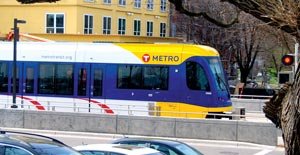Compiled by Jane McClure
Green Line access still a concern
 Green Line light rail is a welcome transportation option for people with disabilities, with easy boarding of trains and space for wheelchairs and mobility scooters. But cracked and pothole-ridden sidewalks, steep slopes, views blocked by tall plantings and gaps between rails and concrete make getting to and from the trains a challenge. In a few places, fire hydrants and light poles placed in the middle of sidewalks make traveling a challenge.
Green Line light rail is a welcome transportation option for people with disabilities, with easy boarding of trains and space for wheelchairs and mobility scooters. But cracked and pothole-ridden sidewalks, steep slopes, views blocked by tall plantings and gaps between rails and concrete make getting to and from the trains a challenge. In a few places, fire hydrants and light poles placed in the middle of sidewalks make traveling a challenge.
Ways to address those concerns were outlined Mar. 11 in a report released by the District Councils Collaborative (DCC). More than 40 people reviewed the report and saw a video, “The First: Last Mile”, demonstrating the difficulty of accessing some rail stations.
The DCC, which is made up of St. Paul district councils and neighborhood organizations along the rail line, studied walkability in 2011-2012. The walkability studies covered north-south streets several blocks north and south of rail stations. Reports were done for each station area. DCC Executive Director Carol Swenson said that evolved into a more in-depth study focused on access for people with disabilities.
“We received sharp criticism from the disability community, that the studies hadn’t done enough to address access,” Swenson said. About 9,050 people with disabilities live within a few blocks of the Green Line. Many live downtown and others live in the seven Public Housing Agency buildings in adjacent neighborhoods. Studies for September 2014 showed that more than 1,000 people with disabilities use five of the stations, with 2,000 using Central Station in downtown St. Paul.
Kjensmo Walker, a person with disabilities, helped with the study. She said access needs to be broadly understood and that meeting federal Americans with Disabilities Act (ADA) guidelines “only scratches the surface” in terms of what accommodations are needed.
One issue the DCC will work on is that of having a place where accessibility complaints can be made, so that those issues can be responded to quickly. Another is to tie into city, county and state plans for transportation and accessibility, and to work with Metro Transit on proposed transit and transit shelter improvements.
Snelling detours set
When Snelling Ave. mill and overlay work, as well as Interstate 94 bridge redecking, gets underway, traffic will be detoured. The St. Paul City Council voted unanimously in March to approve detour routes and road wear and tear compensation from the Minnesota Department of Transportation (MnDOT). MnDOT is involved because Snelling Ave. is a state highway.
Construction gets underway this spring and motorists should watch for signs. The construction area is from Pierce Butler Rte. to Selby Ave.
St. Paul will be compensated $17,315.29 for the “consumption of road life” caused by the detours. The routes posted for detours will be Minnehaha, Prior, and Cretin Ave./Vandalia St. The routes total less than three miles.
Truck weights of up to 9-ton axle loads will be permitted on the detour routes.
The state will handle signage, put up and remove any needed traffic control devices, paint roadway markings and take other steps to control traffic on the detours. MnDOT will also do any street patching as needed during the detour
Brake noise regulated
Noisy “jake brakes,” or compression release engine brakes, have long drawn complaints throughout St. Paul. The devices are used to slow down large trucks, but their noise is disruptive. The St. Paul City Council voted Mar. 18 to ask the Minnesota Legislature to to give St. Paul the authority to prohibit the use of air compression engine brakes on all city freeways, highways, and streets.
The name “jake brake” is used because many of the systems are made by the Jacobs Company. The brakes are used for slowing down on steep grades, or for quick stops. Use of the brakes means being able to shift from highway speeds to a complete stop and back very quickly.
There have been complaints in area neighborhoods about the brakes, along truck routes and the freeway. State Sen. FoUng Hawj, DFL-St. Paul, is revving up the issue at the capitol. Hawj’s district includes I-94, where the noise has drawn complaints.
The City Council resolution states that according to one manufacturer of compression release engine brakes, the decibel level is between 96 and 100 decibels. As a comparison, in St. Paul, rock concerts are limited to 85 decibels.
Comments
No comments on this item Please log in to comment by clicking here